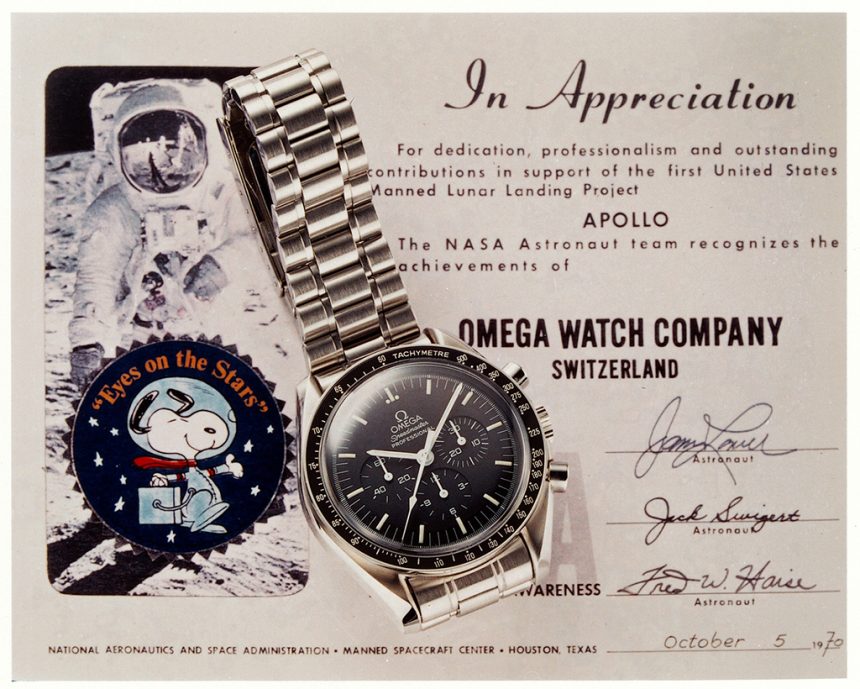The pilot wrist watch is an instrument which has been present in the cockpit since the very beginning of aviation.
The evolution of pilot watches shows aviation has always relied on cutting edge technology, setting trends for all other fields, including watchmaking.
The first ever timepiece for a pilot dates back to 1904.
It was created by Cartier and named Santos, after one of the first European aviation pioneers. It was nowhere near the aviation watches that came later, because in front of being reliable and easy to read-out (these criteria for pilot watches came later), it was stylish.
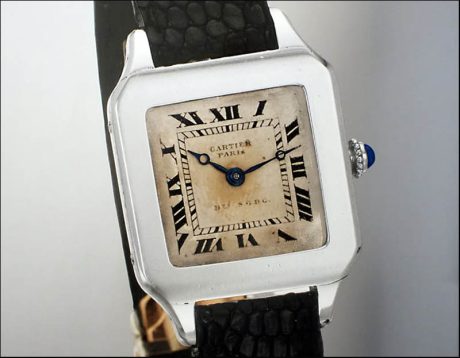
The story is, that Santos, after he made his first flight received a German Archdeacon Aviation Prize for the stunt. The legend says that in the course of celebration Santos complained to his friend, Louis Cartier, that it was hard for him to check what time it was using his pocket watch. This was how the first pilot watch was created. It also was one of the very first wrist watches ever created.
Cartier established the role of an aeronautical watch, as it served several functions. Watch could be used to calculate the fuel consumption, air speed, lift capacity, navigation and finally, it was useful for time keeping.
A second major step was made when an aviation watch was established marketing-wise, as a product. It was when Louis Bleriot made his first flight across the English Channel, or La Manche Channel. The name of the channel depends on your place of residence. The Channel crossing was yet again motivated with money. A thousand pounds prize was offered to anybody who did it first.
It was also the beginning for the media to doubt the technological advance, as the French newspaper Le Matin claimed, the contest was impossible to win, as there was no chance whatsoever of crossing the Channel by a plane. As we all know, Louis Bleriot did it, with a Zenith on his wrist.
After crossing the Channel he said: I am very satisfied with the Zenith watch, which I usually use, and I cannot recommend it too highly to people who are looking for precision.
After all Bleriot was a hero. And this was one of the first examples of using brand endorsement in marketing. Again, on the cutting edge of aviation.
The greatest steps in development of the aviation wrist watches were yet to happen.
The first use of an airplane in war, as a weapon was a major step. The watches were also to evolve during that period, as they started to get used as navigation instruments. The main purpose of a watch here, was to make a coordinated attack possible at a precise moment. British pilots flew with the pocket watches Mark IV.A (1914) and Mark V (1916).
These watches were produced by Doxa and had a sign of being destined for aviation (Letter ‘A’ with an arrow) use on the back of the case. Needless to say – they were one of the first standard issues.
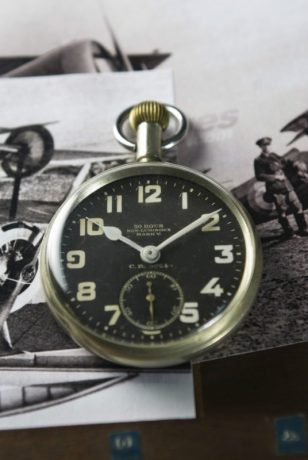
A peculiar feature of these watches was their long crown housing. The purpose of that was to make them fittable into the instrument panel, and in that way during the flight they were just another gauge there, hence the name – cockpit watch.
It was during the WWI when the first luminous hands appeared on a watch, as night flying required the watch to be still readable in the poor light conditions.
Some of the cockpit watches did have anonymous producers from all around Britain, nevertheless some of them were not anonymous, as the four known manufacturers of Mark V watches were Zenith, Omega, Doxa and Electa.
Longines was another manufacturer that is associated with the aviation timepieces even today. Longiness in the period between the World Wars was an official Olympics timekeeper, as Omega is today. It was also between the WWI a II when Charles Lindbergh made his non-stop solo Atlantic crossing.
Needless to say, he used a Longines watch.
During the Lindbergh’s Atlantic flight Longines was a navigation instrument, as time was the main way of telling where he was. Over the Ocean there are no landmarks, just water all around the horizon. The watches were not so accurate as they are now. Longines used an idea of a rotating inner dial that could be set in order to get rid of the lack of accuracy.
The pilot listened to a minute beeps over the radio and aligned the dial using the signals as a reference. Here is how a rotating bezel was invented. Lindbergh’s watch also allowed the pilot to determine an hour angle with a decent precision. This was a large navigational help.
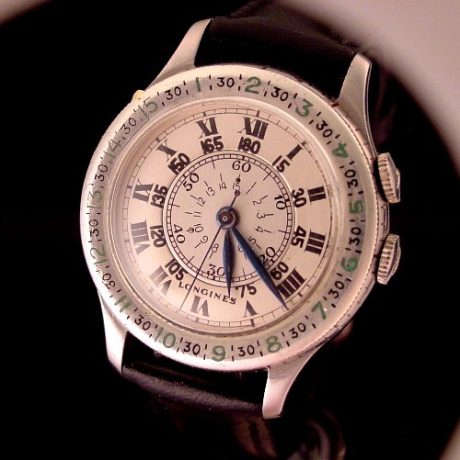
In 1939 WW2 started. Again the technology was on a quick development curve, as new inventions in the field of aviation were created. When Adolf Hitler reestablished the Luftwaffe back in 1935 the German industry started to prepare for a conflict. So did the watch industry as well.
RLM (Reichs-Luftfahrtministerium, or Reich’s Ministry of Air Transport) was seeking for a standard issue watch for the bomber crews. The design was similar to the Lindbergh’s watch with the hour angle indication, but the B-Uhr was ultimately looking different. And it is so iconic that it is a model for any aviation watch today.
Beobachtungs-uhren (Observation watches) were a standard issue, but they were owned by Luftwaffe, not the pilots. They had to return them after the flight. The watch during the flight was synchronized (manualy) with a radio beep from the base. It was a common method these days, and this is an early form of contemporary Radio Controlled watches.
Five companies manufactured the B-Uhr: A. Lange & Söhne, Wempe, Lacher & Company/Durowe (Laco), and Walter Storz (Stowa). Wempe and Stowa used Swiss movements.

As the Jet Age arrived, with the rising speeds of the aircraft the watches had to be more and more accurate.
The Cold War watches were much larger in size. When it comes to that period aviation timepieces, they were modelled after British made Smith W10. Whole array of clones emerged, manufactured by companies such as Hamilton, CWC and MWC.
The CWC watch basically established the model for a contemporary aviation watch. Nevertheless there are still some features that are more common nowadays.
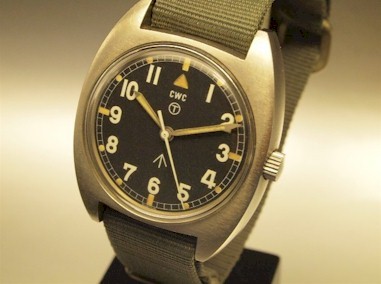
Another feature that was first introduced in military watches were the tritum-lit hands. Tritum, being a radioactive isotope is luminous in the darkness. Tritum tubes on hands of the watch provide 20 years of illumination.
One of them is a GMT hand. GMT hand, usually set according to the Greenwich timezone allowed the pilot to calculate the time in different timezones.
One of the most famous watches that featured the GMT hand was the Rolex GMT Master, including a two-toned blue-red bezel, which is called by watch specialists a pepsi bezel. The GMT hand on GMT master goes around the dial once every 24 hours, and was set for the London timezone. The bezel has 24 hours on the scale. If 24 was aligned with 12 on the main dial, then the watch indicated the Greenwich time. But in order to check what time it was in different timezones the pilot only had to rotate the bezel as a point of reference.
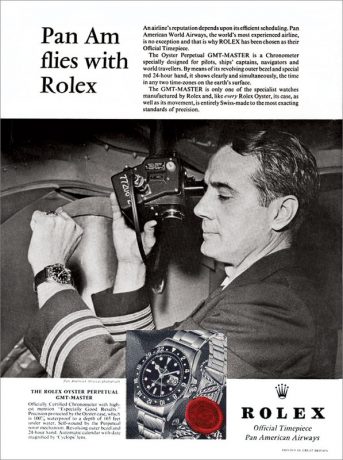
Rolex GMT Master was a standard issue watch for Pan Am pilots for a long time.
During the Cold War, besides aviation, space was a major research field. This field also required new watches, as lack of gravity was a factor that certainly had an influence on the accuracy of a timepiece.
NASA used Bulova electronic clock in their first space missions. Nonetheless the astronauts, as they were pilots at the same time, were stuck to wearing their own wristwatches. In this respect Yuri Gagarin worn a Sturmanskie watch, while Scott Carpenter used a Breitling Navitimer.
But it was the Omega Speedmaster that was an ultimate astronaut watch. NASA chose this very watch to go to the Moon after a long testing phase: the Speedmaster was the only watch to fulfil all the agency’s requirements.
On one of the Apollo missions though, astronauts reported that due to the low, near vaccum pressure on the Moon, one of the watch crystals popped out.
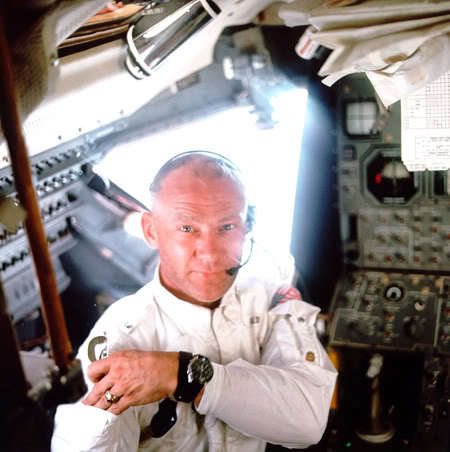
The 1970s were a boom time for electronic watches, and this kind of watch was mostly used on Skylab or Mir missions.
“Astronauts had the option of wearing two watches in space, and lots of digital watches began riding up in the early 1970s,” said Jim Lovell, an American astronaut. The introduction of quartz movements was a milestone which set the new standards as to the watch accuracy.
Nevertheless in July 1980 U.S. Navy requested a mechanical, manualy wound watch to be its standard timepiece at the time. It might seem odd, but even today most of the pilot watches feature an analog dial instead of digital display.
Contemporary pilot watches feature functionalities that are specifically suited for aviation. Here we will describe just two watches that are used quite extensively and will enlist the features that make them good aviation watches. The are hundred more types around that have similar or better features and each pilot makes his choice based on his/her style and needs.
First one is Breitling Emergency.
This watch has a feature that might become lifesaving for a downed pilot. The watch contains two mechanisms. The first one has a standard quartz watch that features a digital chronograph and second timezone display along with an analogue dial. The second one is a distress beacon with an antenna, that can be used by a downed pilot to call for help.
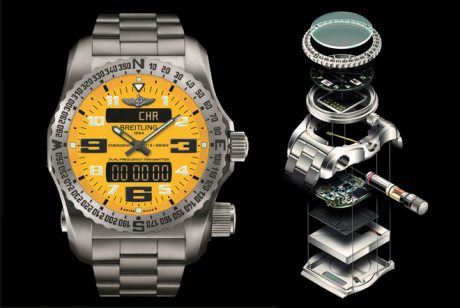
According to the Breitling website, the watch transmits a first digital signal on the 406 MHz frequency intended for satellites and lasting 0.44 seconds every 50 seconds; as well as a second analog signal on the 121.5 MHz homing and rescue frequency, lasting 0.75 seconds every 2.25 seconds.
Breitling Emergency can be often spotted on the wrists of the Western pilots. As the Breitling company claims, if the transmitter is used in a real emergency the watch will be replaced for free.
The second watch – Citizen Promaster Skyhawk AT JY0080-62E – is used by Polish Air Force F-16 pilots. It is a standard issue watch, which has several aviation related features.
It is radio controlled, so there is no need of setting the time manually and it can indicate time for all the timezones.
Complications (this is what a function of a watch is called) include a chronograph, a timer, two alarms, GMT time and a perpetual calendar. The Eco-Drive solar charging rids the watch of the battery maitenance.
The final feature of the Skyhawk that is so peculiar for aviation watches is the so called slide-rule bezel. This bezel allows the watch user to perform many kinds of calculations, including aviation related ones, such as fuel consumption, unit conversion, square root. Skillfuly used it is a great aid in navigation, as many of the calculations are still done in your memory, e.g. on intercept missions.
Here below is the Skyhawk on the wrist of the Polish Viper driver Lt. Michał ‘Poidog’ Kiczynski, flying the F-16 in the 32 AB in Łask.
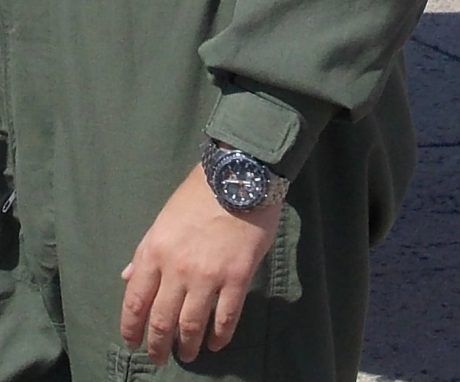
So, if Santa’s brought you one of the above aviation wrist watches for Christmas, with this short and incomplete story about the most famous models, you know a bit more about its history now.

